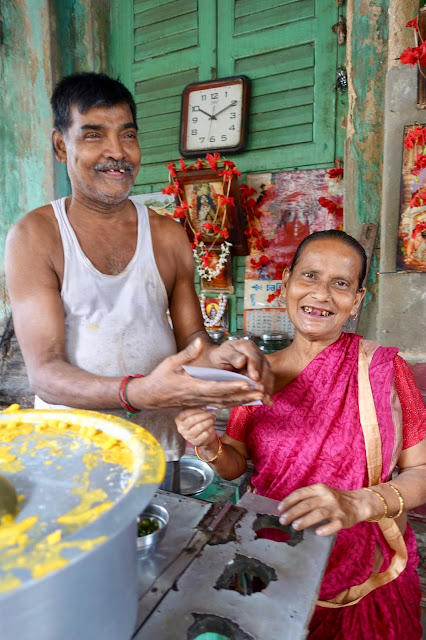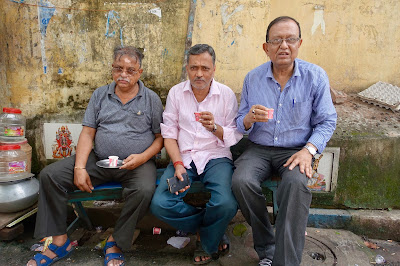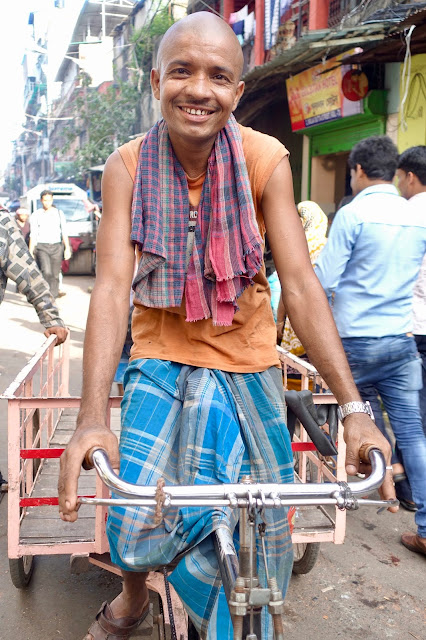Kolkata is surely one of the most visually inspiring cities in the world. Its streets are filled with people working and idling, buying and selling, eating, drinking and transporting goods from one place to another. But despite the constant activity the citizens of Kolkata are almost always ready to spend a few minutes talking to a visitor who is interested in them, their lives and their story. And this is a city of stories, many of them written on the faces of the people in its streets, set against a unique architectural background. I came here for the first time last year and since then have been longing to return, to renew my acquaintance with India's former capital city, to meet more of her people and to record their stories with my camera.
If Kolkata is my one of my favourite cities, then Chitpur Road is one of my favourite streets. This long, long street is chaotic with commerce of all kinds being carried out from early morning to late at night, much of it in buildings that date back up to 200 years. It is badly dilapidated in parts but this does not seem to affect its importance and it is still possible to see crafts being carried out here that have disappeared elsewhere. One craft that is certainly not dying out is that of the chaiwallah or tea seller, offering steaming hot chai to thirsty passers by often from a roadside stall or a tiny "hole in the wall". Strolling along Chitpur I noticed an elegant woman in a green and white sari working as a chaiwalli. I wondered if the man sitting near her was her husband. When asked if this was the case she said "Him? No, he is a customer". Then she laughed. Quite a lot. He didn't. A case of mistaken identity.
Running off Chitpur, Zakaria Street is in a predominantly Muslim area and home to the magnificent Nekoda mosque. It is full of small shops selling food, paan, jewellery and clothes. It is also a rich source of interesting pictures. The people are generally open to being photographed and are genuinely curious about visitors. The man pictured smoking spotted me taking pictures, lit up a bidi and began playing up to the camera. I loved the results. He looks directly at the camera, takes a drag and blows the smoke down in a cloud around his throat whilst his yellow kurta and checked lunghi contrast with the colourful backdrop.
Walking into an alley off the main part of the street I found myself in a small tailors owned by one Mohammed Ishmail who sat near Gulab, a much younger man working at a sewing machine. Mister Ishmail explained that his was a long established family business. When I enquired what relation the tailor was to him, he replied in English "he is my servant". The tailor looked a little surprised as must have I because Mohammed corrected himself saying "that is, he is my staff". Another case of mistaken identity I fear.
There is an enormous recycling bazaar in one of the side streets off Zakaria. This is not recycling as many people in the west would know it. This is the real thing. Metal, wood and cardboard goods are collected from various place around the city, brought here, dismantled and used to create new tools, furniture and other items. Workers sit surrounded by piles of materials using Indian ingenuity to give new life to discarded belongings. Sparks fly from welding and there is the constant sound of hammering as old nails are straightened in order to be used again. The man pictured above was winding thick lengths of wire ready to be sold and used again.
I like a joke, including a joke at my expense if the intention is not malicious. I often meet a joker on my travels and on this occasion it was delivery man Feroz Khan of the sparkling smile and bald head who asked me to take his picture before pointing at my head and announcing in English "you and me same to same hahaha". I'm sure I don't know what he means. Cheeky chap.
If Kolkata is one of my favourite cities, its 24 hour vegetable market is one of my favourite quarters. Full of life, colour and activity it is a photographer's dream. The market's management allows a small number of people to collect vegetables that have been dropped on the floor or are less than perfect but still edible and to sell them from small patches outside the main wholesale hall. These people are extremely poor and this is a way to help them earn a little extra money to support their families. One of them, an older woman selling ginger and wearing brightly coloured clothing smiled at me and wished me good morning. She seemed different to the other vendors, comfortable in her self and of her lot and I felt sure she would agree to be photographed. She did and is pictured above.
As well as the hundreds of wholesalers who have shops here, there are many small scale vendors on the periphery of the market who sell items directly to the public. I noticed one such vendor - a young woman slicing the tops off coconuts and then selling the juice to thirsty customers. I indicated that I wanted three coconuts, one each for me and my two friends and asked her how many rupees. She threw her hands up in the air and in a surprisingly husky voice replied "Rupees? Pay me in dollars, I want to buy a house". I happened to have two dollars in my pocket and was tempted to call her bluff but her expertise in slicing the tops off coconuts dissuaded me from attempts at humour. Her six year old daughter Jazmina sat behind her smiling and then poking her tongue out at the camera. I hope they get their house one day.
Some of the vendors are now used to being photographed, due in large part to the tours organised by Calcutta Photo Walks. Not only that, some of the vendors are now pretty clued up themselves about what makes a good shot or who is particularly photogenic. A herb seller called me over and told me to photograph two of the young women working for him. At first they seemed reluctant, laughing a little and feigning shyness. I was on the point of giving up when they stood beside each other and offered the camera two fabulous smiles. Perseverance works.
Less shy were what I assume to be a married couple who were brushing their teeth with liquorice roots. It is not uncommon to see men and children do this in public but never an adult woman. And I've certainly never seen a woman come close to the camera and demonstrate her teeth brushing technique alongside the man who might have been her husband. Note I said "might" - hoping to avoid another case of mistaken identity.
But perhaps the most interesting person I met in the market was a man who makes and sells essential oils. The oils are sold in tiny bottles kept in a small, lovingly cared for wooden box which houses a series of drawers. Used for aromatherapy the mixtures include differing quantities of bark, leaves, flowers, resins, peel, seeds and other natural materials. The vendor's explanation attracted a small crowd of young people, interested to hear. In the past there were many such vendors but this is now a dying art. Less and less of these oils are being produced by traditional practitioners. He was very happy to be photographed and proudly displayed his collection for the camera.
I have been advised that when in India I should expect the unexpected. Turning into a side street off Chitpur Road I was struck by the fashion model elegance of a couple of young men stood talking to each other. Both delivery men, they seemed unaware of their good looks and were surprised that I wanted to photograph them. I had a similar moment last year in Haryana when I saw a Rajasthani farmer walking with his cattle. He would not have been out of place on the cover of Vogue.
Last year I photographed a chaiwallah in Beadon Street, North Kolkata. He first caught my attention due to the brightly coloured backdrop of his stall. I then secured his permission for a portrait through a customer since he did not speak English. My volunteer interpreter told me the chaiwallah's name was Mohan Lal and that he came from Bihar. It turned out to be one of the best pictures of my first trip to India and keen to present him with a copy, I spent three days looking for him along Beadon Street before eventually finding him. He was both surprised and delighted as was his wife who after a little persuasion joined him in another picture. And something strange. Not only is he not called Mohan Lal, he is not from Bihar either. He is Dilip Ghosh, a Bengali, born in Kolkata. Despite the confusion he told me that business is good - so good that he produces a calendar every year to give to his regular customers. Fabulous. I hope to meet the Ghosh family again one day.
Still on the subject of tea, when walking through the lanes of the Bhawanipur neighbourhood I passed three men of a certain age who were sitting on a bench and enjoying a cup of chai. They waved to me and wished me "good afternoon". I can't resist a chat and they insisted I drink a cup with them. Mr. Mitra, Mr. Das and Mr. Sarkar turned out to be real gentlemen, speaking a very formal English and enquiring about my family, health and the weather. Now what was that about expecting the unexpected?
If Kolkata is my one of my favourite cities, then Chitpur Road is one of my favourite streets. This long, long street is chaotic with commerce of all kinds being carried out from early morning to late at night, much of it in buildings that date back up to 200 years. It is badly dilapidated in parts but this does not seem to affect its importance and it is still possible to see crafts being carried out here that have disappeared elsewhere. One craft that is certainly not dying out is that of the chaiwallah or tea seller, offering steaming hot chai to thirsty passers by often from a roadside stall or a tiny "hole in the wall". Strolling along Chitpur I noticed an elegant woman in a green and white sari working as a chaiwalli. I wondered if the man sitting near her was her husband. When asked if this was the case she said "Him? No, he is a customer". Then she laughed. Quite a lot. He didn't. A case of mistaken identity.
Running off Chitpur, Zakaria Street is in a predominantly Muslim area and home to the magnificent Nekoda mosque. It is full of small shops selling food, paan, jewellery and clothes. It is also a rich source of interesting pictures. The people are generally open to being photographed and are genuinely curious about visitors. The man pictured smoking spotted me taking pictures, lit up a bidi and began playing up to the camera. I loved the results. He looks directly at the camera, takes a drag and blows the smoke down in a cloud around his throat whilst his yellow kurta and checked lunghi contrast with the colourful backdrop.
Walking into an alley off the main part of the street I found myself in a small tailors owned by one Mohammed Ishmail who sat near Gulab, a much younger man working at a sewing machine. Mister Ishmail explained that his was a long established family business. When I enquired what relation the tailor was to him, he replied in English "he is my servant". The tailor looked a little surprised as must have I because Mohammed corrected himself saying "that is, he is my staff". Another case of mistaken identity I fear.
There is an enormous recycling bazaar in one of the side streets off Zakaria. This is not recycling as many people in the west would know it. This is the real thing. Metal, wood and cardboard goods are collected from various place around the city, brought here, dismantled and used to create new tools, furniture and other items. Workers sit surrounded by piles of materials using Indian ingenuity to give new life to discarded belongings. Sparks fly from welding and there is the constant sound of hammering as old nails are straightened in order to be used again. The man pictured above was winding thick lengths of wire ready to be sold and used again.
I like a joke, including a joke at my expense if the intention is not malicious. I often meet a joker on my travels and on this occasion it was delivery man Feroz Khan of the sparkling smile and bald head who asked me to take his picture before pointing at my head and announcing in English "you and me same to same hahaha". I'm sure I don't know what he means. Cheeky chap.
If Kolkata is one of my favourite cities, its 24 hour vegetable market is one of my favourite quarters. Full of life, colour and activity it is a photographer's dream. The market's management allows a small number of people to collect vegetables that have been dropped on the floor or are less than perfect but still edible and to sell them from small patches outside the main wholesale hall. These people are extremely poor and this is a way to help them earn a little extra money to support their families. One of them, an older woman selling ginger and wearing brightly coloured clothing smiled at me and wished me good morning. She seemed different to the other vendors, comfortable in her self and of her lot and I felt sure she would agree to be photographed. She did and is pictured above.
As well as the hundreds of wholesalers who have shops here, there are many small scale vendors on the periphery of the market who sell items directly to the public. I noticed one such vendor - a young woman slicing the tops off coconuts and then selling the juice to thirsty customers. I indicated that I wanted three coconuts, one each for me and my two friends and asked her how many rupees. She threw her hands up in the air and in a surprisingly husky voice replied "Rupees? Pay me in dollars, I want to buy a house". I happened to have two dollars in my pocket and was tempted to call her bluff but her expertise in slicing the tops off coconuts dissuaded me from attempts at humour. Her six year old daughter Jazmina sat behind her smiling and then poking her tongue out at the camera. I hope they get their house one day.
Less shy were what I assume to be a married couple who were brushing their teeth with liquorice roots. It is not uncommon to see men and children do this in public but never an adult woman. And I've certainly never seen a woman come close to the camera and demonstrate her teeth brushing technique alongside the man who might have been her husband. Note I said "might" - hoping to avoid another case of mistaken identity.
But perhaps the most interesting person I met in the market was a man who makes and sells essential oils. The oils are sold in tiny bottles kept in a small, lovingly cared for wooden box which houses a series of drawers. Used for aromatherapy the mixtures include differing quantities of bark, leaves, flowers, resins, peel, seeds and other natural materials. The vendor's explanation attracted a small crowd of young people, interested to hear. In the past there were many such vendors but this is now a dying art. Less and less of these oils are being produced by traditional practitioners. He was very happy to be photographed and proudly displayed his collection for the camera.
I have been advised that when in India I should expect the unexpected. Turning into a side street off Chitpur Road I was struck by the fashion model elegance of a couple of young men stood talking to each other. Both delivery men, they seemed unaware of their good looks and were surprised that I wanted to photograph them. I had a similar moment last year in Haryana when I saw a Rajasthani farmer walking with his cattle. He would not have been out of place on the cover of Vogue.
 |
| Dilip and Mrs Ghosh, Beadon Street |
Still on the subject of tea, when walking through the lanes of the Bhawanipur neighbourhood I passed three men of a certain age who were sitting on a bench and enjoying a cup of chai. They waved to me and wished me "good afternoon". I can't resist a chat and they insisted I drink a cup with them. Mr. Mitra, Mr. Das and Mr. Sarkar turned out to be real gentlemen, speaking a very formal English and enquiring about my family, health and the weather. Now what was that about expecting the unexpected?
 |
| Tea drinkers of Bhawanipur |
You might also like Scenes From The City of Joy - 1, The Rickshaw Pullers of Kolkata
You can see more pictures from Kolkata here.
Manjit of Calcutta Photo Walks again accompanied me at the market, leading me to some great shots, explaining how the market works, interpreting and generally making things fun. he can also advise on technique. His tours are highly recommended.












No comments:
Post a Comment